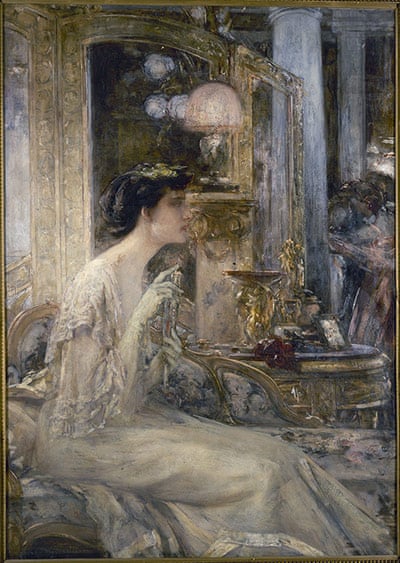因为今年 Philharmonia Orchestra 举办 系列《City of light》音乐会 , 我也觉得很奇怪 , 为什么叫《City of light》呢? 原来巴黎是欧洲的城市里最早使用街灯的,street lighting, 巴黎也是启蒙时代 教育和艺术中心 , 当年那么多英国青年被公派私派去欧洲旅游, 罗马,巴黎是必须的。
Philharmonia Orchestra的 系列《City of light》主要集中 在巴黎1900-1950年 年代的作曲家, 那是一个音乐,艺术, 科技交相辉映的年代, 一个城市仅有科技,机器,光还是不够
巴黎伦敦, 简直就是〈双城记〉, 不论怎么政治上的分歧,在音乐艺术上, 伦敦总是很谦虚的, 在伦敦有看不完的 〈巴黎〉
《City of light》, 《Inventing Impressionism》正是个机会让我走进巴黎, 和巴黎的Belle Epoque

Jean Béraud
Parisienne, place de la Concorde
Circa 1890
Musée Carnavalet/Roger-Viollet

Chez la Modiste,
Between 1905 and 1910

En soirée, portrait de Madame Pascal Blanchard
1903

Henri Gervex
Un soir de grand prix au pavillon d'Armenonville
1905
Musée Carnavalet/Roger-Viollet

Le Balcon
1905-1906
Paris 1900 exhibition shows City of Light at its brightest (zt)


Pollution, economic woes, political uncertainty and a crisis of confidence have cast a smoggy grey cloud over Paris, like the rest of France, of late. But it was not always this way.
An exhibition that opened this week has served as a timely and contrasting reminder to pessimistic Parisians of the former glory of their capital. The event, Paris 1900, is being staged at the Petit Palais, a magnificent, often overlooked, palace on the right bank of the Seine, and shows the City of Light at its brightest during the period known as La Belle Époque.
At the start of the 20th century the eyes of the world were on the French capital. The Universal Exhibition, for which the Petit Palais and its even more impressive neighbour, the Grand Palais, were built, made the city a showcase for the world.
Cézanne, Monet, Renoir, Pissarro and Toulouse-Lautrec, among many others, experimented with symbolism, and what would become recognised as the Impressionist movement. Grand stations like the Gare d'Orsay – works of art in their own right – were being built, while Fulgence Bienvenüe, the "Father of the Métro", was overseeing his first underground line.

Arts of all disciplines and sciences flourished. Travel and adventure were opening up swaths of the southern hemisphere, which were often quickly colonised. Absinthe was driving artists mad, mind-altering drugs were taken, poverty and prostitution were given the oil painter's gloss.
But it was to be a brief supernova before the horrors of the first world war brought darkness and slaughter to the continent.
Strolling through the exhibition's six "pavilions" at the recently renovated Petit Palais, it is clear the outward-looking, imaginative and self-assured Paris of 1900 is a world away from today's city, battered and bruised by a global economic recession and erring towards gloom.
"Paris in 1900 was enjoying a period of great joy, of huge optimism," said Christophe Leribault, recently appointed director of the Petit Palais, who gathered the 600 exhibits in 12 months.
"It was a time of cultural abundance, of arts, of science, of invention, of colonisation of parts of the world by France, Britain and Belgium. This exhibition is a celebration of that time and highlights the mythical nature of Paris and La Belle Époque.

"It is this image of Paris, with all its attractions, the beaux arts, the artistic salons, right down to the prostitutes and bordellos, that we wanted to celebrate."
He added: "Looking back there were of course signs of trouble, but nobody then could have guessed the horrors of war that were to come. Parisians were optimistic, confident, discovering things, looking forward."
The optimism of La Belle Époque did not last. Today, France is battling to keep its reputation as the centre of the civilised, cultured world, but a walk around its capital shows how much of its former glory shines on.
The exhibition at the Petit Palais, built for the 1900 universal exhibition and named Musée des Beaux-arts in 1902, will run until 7 August.
http://www.theguardian.com/artanddesign/2014/apr/03/paris-1900-exhibition-le-petit-palais

Poster of the Universal Exhibition Palais de l'Optique
1900
Musée Carnavalet/Roger-Viollet